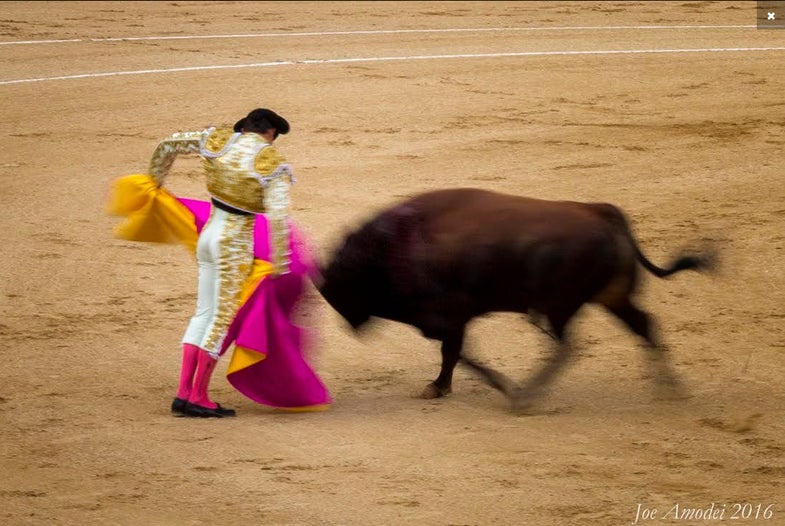Mentor Series: Poetry in Motion in Spain
If you’ve read Hemingway, you know how a bullfight goes down. But Joe Amodei didn’t come to Madrid to write...


If you’ve read Hemingway, you know how a bullfight goes down. But Joe Amodei didn’t come to Madrid to write his own Death in the Afternoon—he wanted to capture the experience with a camera.
Working the scene from his seat in the stands with his fellow Mentor Series trekkers, Amodei zoomed wide for the atmospherics and parade shots and tight on the matador and bull to keep the peak action large in the frame. During the bull’s passes, he isolated the figures against the sand. At the suggestion of mentor David Tejada, he experimented with double exposures. He panned, then held still. All the while he tried different shutter speeds—fast to freeze action and slow to convey motion through blur.
“You become absorbed in the moment, thinking, Bull. Matador. Cape. 1/30 sec. 1/60 sec. 1/500 sec. Keep it off center,” he recalls. “You’re trying to think, trying to play with the camera. I knew I’d never go back to a bullfight, so I had to make the most of this opportunity.”
The bright but soft light of late afternoon—about two hours before sunset in early September—made exposure easy. And it brought out the brilliant pink and yellow of the matador’s cape.
Amodei, whose passion is street photography, had arrived in Barcelona a few days before his Mentor Series adventure began in order to wander the streets looking for the kinds of juxtapositions that make a great street shot.
That preparation paid off in the photograph shown here. Pointing to the three blurred feet of the charging bull, in contrast to its planted foreleg and the sharpness of the matador’s feet and hat, he says, “It has a lot going on.”
If you’ve read Hemingway, you know how a bullfight goes down. But Joe Amodei didn’t come to Madrid to write his own Death in the Afternoon—he wanted to capture the experience with a camera.
Working the scene from his seat in the stands with his fellow Mentor Series trekkers, Amodei zoomed wide for the atmospherics and parade shots and tight on the matador and bull to keep the peak action large in the frame. During the bull’s passes, he isolated the figures against the sand. At the suggestion of mentor David Tejada, he experimented with double exposures. He panned, then held still. All the while he tried different shutter speeds—fast to freeze action and slow to convey motion through blur.
“You become absorbed in the moment, thinking, Bull. Matador. Cape. 1/30 sec. 1/60 sec. 1/500 sec. Keep it off center,” he recalls. “You’re trying to think, trying to play with the camera. I knew I’d never go back to a bullfight, so I had to make the most of this opportunity.”
The bright but soft light of late afternoon—about two hours before sunset in early September—made exposure easy. And it brought out the brilliant pink and yellow of the matador’s cape.
Amodei, whose passion is street photography, had arrived in Barcelona a few days before his Mentor Series adventure began in order to wander the streets looking for the kinds of juxtapositions that make a great street shot.
That preparation paid off in the photograph shown here. Pointing to the three blurred feet of the charging bull, in contrast to its planted foreleg and the sharpness of the matador’s feet and hat, he says, “It has a lot going on.”